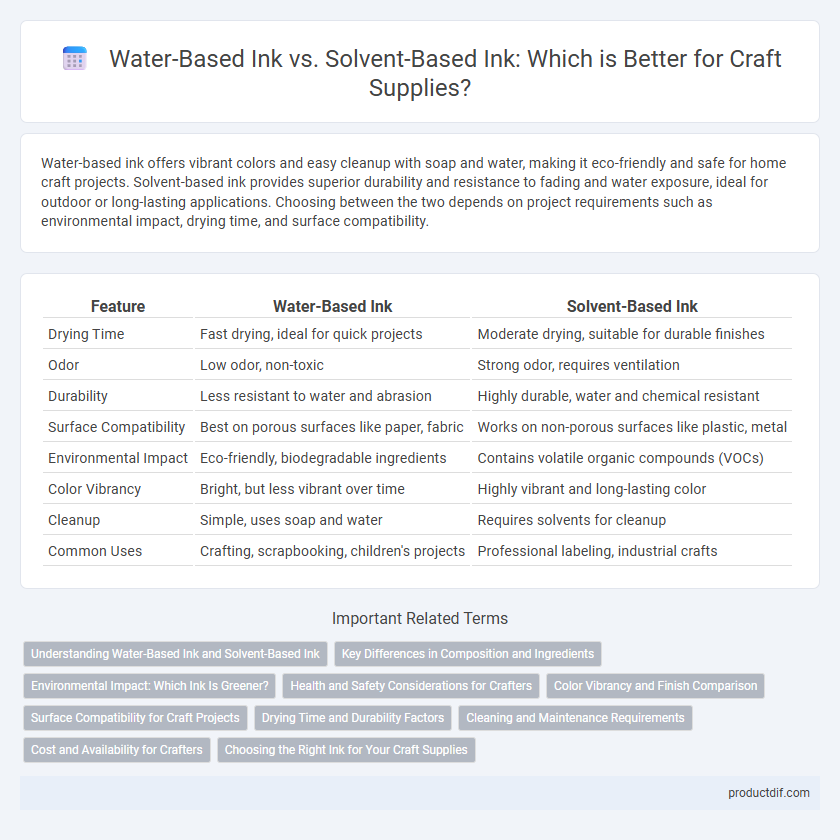Water-based ink offers vibrant colors and easy cleanup with soap and water, making it eco-friendly and safe for home craft projects. Solvent-based ink provides superior durability and resistance to fading and water exposure, ideal for outdoor or long-lasting applications. Choosing between the two depends on project requirements such as environmental impact, drying time, and surface compatibility.
Table of Comparison
| Feature | Water-Based Ink | Solvent-Based Ink |
|---|---|---|
| Drying Time | Fast drying, ideal for quick projects | Moderate drying, suitable for durable finishes |
| Odor | Low odor, non-toxic | Strong odor, requires ventilation |
| Durability | Less resistant to water and abrasion | Highly durable, water and chemical resistant |
| Surface Compatibility | Best on porous surfaces like paper, fabric | Works on non-porous surfaces like plastic, metal |
| Environmental Impact | Eco-friendly, biodegradable ingredients | Contains volatile organic compounds (VOCs) |
| Color Vibrancy | Bright, but less vibrant over time | Highly vibrant and long-lasting color |
| Cleanup | Simple, uses soap and water | Requires solvents for cleanup |
| Common Uses | Crafting, scrapbooking, children's projects | Professional labeling, industrial crafts |
Understanding Water-Based Ink and Solvent-Based Ink
Water-based ink is made from pigments or dyes suspended in a water solvent, offering eco-friendly properties, low odor, and easy cleanup, making it ideal for paper and fabric crafts. Solvent-based ink contains organic solvents that provide durable, vibrant colors with strong adhesion on non-porous surfaces like plastics and metals but involves higher VOC emissions and requires proper ventilation. Choosing between these inks depends on project material, environmental impact preferences, and desired finish durability.
Key Differences in Composition and Ingredients
Water-based ink primarily consists of pigments suspended in water with natural or synthetic binders, making it non-toxic and environmentally friendly. Solvent-based ink contains organic solvents that dissolve the pigment and binder, offering superior adhesion and durability on non-porous surfaces but releasing volatile organic compounds (VOCs). The key differences lie in water-based ink's biodegradability and low odor versus solvent-based ink's chemical complexity and strong solvent fumes.
Environmental Impact: Which Ink Is Greener?
Water-based inks have a significantly lower environmental impact compared to solvent-based inks due to their reduced volatile organic compound (VOC) emissions and non-toxic composition, making them safer for indoor air quality and waste disposal. Solvent-based inks release harmful VOCs that contribute to air pollution and require careful handling and disposal to prevent soil and water contamination. Choosing water-based ink supports sustainable crafting by minimizing ecological harm and promoting safer manufacturing practices.
Health and Safety Considerations for Crafters
Water-based ink offers a safer alternative for crafters due to its low toxicity and minimal volatile organic compounds (VOCs), reducing risks of respiratory irritation and skin sensitivities. Solvent-based ink contains higher levels of VOCs and strong odors, necessitating proper ventilation and protective gear to prevent harmful exposure. Choosing water-based ink supports a healthier crafting environment, especially for hobbyists working in enclosed spaces or with limited protective equipment.
Color Vibrancy and Finish Comparison
Water-based ink offers vibrant colors with a softer, matte finish ideal for natural, eco-friendly craft projects, while solvent-based ink delivers intense, glossy hues that excel in durability and weather resistance. The pigments in solvent-based inks penetrate surfaces more deeply, enhancing color longevity and sharpness on non-porous materials like plastic and metal. Water-based inks, however, perform best on porous surfaces such as fabric and paper, providing rich but more subdued tones with a smooth, matte appearance.
Surface Compatibility for Craft Projects
Water-based inks excel on porous surfaces like paper, fabric, and wood, offering vibrant colors and easy cleanup ideal for craft projects. Solvent-based inks are better suited for non-porous materials such as glass, plastic, and metal, providing superior adhesion and durability. Choosing the right ink depends on the surface type to ensure longevity and quality of the craft design.
Drying Time and Durability Factors
Water-based ink offers faster drying times on porous surfaces due to its quick evaporation of water, making it ideal for rapid craft projects. Solvent-based ink, while slower to dry, provides superior durability and resistance to water and fading, ensuring long-lasting craft items. Choosing between these inks depends on the balance needed between quick project completion and the longevity of the finished product.
Cleaning and Maintenance Requirements
Water-based inks require simpler cleaning processes using just soap and water, making maintenance more eco-friendly and less toxic. Solvent-based inks demand specialized solvents for cleaning, which increases handling time and necessitates proper ventilation due to harmful fumes. Regular maintenance of solvent-based equipment is critical to prevent clogging and ensure consistent print quality.
Cost and Availability for Crafters
Water-based inks typically have a lower upfront cost and are more widely available in craft stores, making them accessible for hobbyists and small-scale projects. Solvent-based inks usually come at a higher price point due to their durability and specialized use, often requiring purchase from specialty suppliers. Crafters should consider budget constraints and local availability when choosing between water-based and solvent-based inks for their projects.
Choosing the Right Ink for Your Craft Supplies
Water-based ink offers vibrant colors and eco-friendly properties, making it ideal for paper, fabric, and porous surfaces in craft projects. Solvent-based ink provides superior durability and resistance to water and fading, perfect for non-porous materials like plastic, metal, and glass. Selecting the right ink depends on the surface type and desired longevity, with water-based inks being safer for indoor use and solvent-based inks excelling in outdoor or heavy-use crafts.
Water-based ink vs Solvent-based ink Infographic

 productdif.com
productdif.com